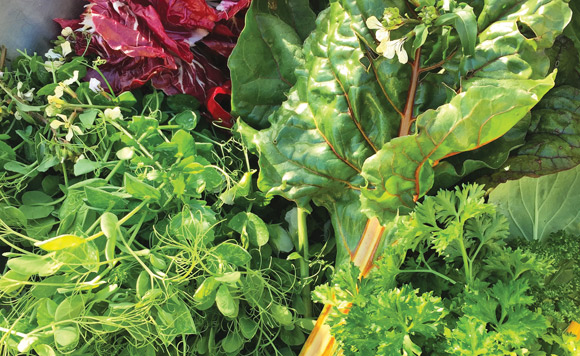by Solara Goldwynn, Hatchet & Seed –
Eating locally in September is a feast for the senses. After an intensely warm summer, and an unprecedented forest fire season, the coming change to autumn is a welcome sight for many. Farmers markets are filled with the bounty of the season and all the love and hard work our local farmers have put into their products can be seen in our filled baskets and on our dinner plates. Farm-to-table and even garden-to-table is just easier this time of year.
The farm-to-table movement is slowly becoming less of a passing trend and more of a cultural norm. The more people experience fresh, in season, local produce, the more the demand grows. Many restaurants now feature local farms and are strong proponents of the local food movement, introducing patrons to the flavours of the season and region. Other initiatives are replicating this model, such as farm-to-school programs which help bring local food to cafeteria programs and not only feed students fresh, healthy food but educate both students and teachers on the importance of food security.
Here are some of the benefits of farm-to-table: food that doesn’t travel long distances is higher in nutrients; less fossil fuels are needed for transportation and refrigeration of food grown close to home; buying local food helps the local economy by supporting farmers and food producers; eating local keeps you in tune with the seasons; supporting local farmers helps to preserve farmland; eating local food creates a vibrant food culture and encourages a healthy whole food diet; and less packaging is required!
However, as we know, because of the current “cheap fossil fuel paradigm,” local food is often a more expensive choice for the consumer than something imported from across the globe. Many of us find that being able to afford and access local food can be challenging, even though supply and demand is increasing.
If you walk into any grocery store you will notice that only a small amount of the food (produce and packaged) is from the Island. Vancouver Island agriculture produces less than 10% of the food it consumes, and we import the rest. With our population growing, many farmers retiring and the cost of land (especially farmland) on the rise, this percentage will most likely decline over the next few years unless we collectively make local food, and the production of it, more available to everyone.
It is vital that we support our local farms, use our farmland for growing food and train a new generation of farmers. We can also encourage each other and our municipalities to make food growing a part of our culture.
If you have a balcony or a patch of land, you can start by growing one thing you enjoy eating. Develop your green thumb! Gardening is a skill that can be cultivated over time. Reflect on the connection between local food and culture in your own life; nurture those stories and tell them to the children in your life. Support farmers by not only buying directly from them, but also encouraging the restaurants and grocers around us to support them too. And let’s encourage our municipalities to replace dying trees with edible nut trees and to invest more money in expanding community gardens, school gardens, hospital gardens, etc.
Here are some local food resources:
https://islandfarmfresh.com
http://www.bcfarmersmarket.org/nutrition-coupon-program
http://lifecyclesproject.ca/.




